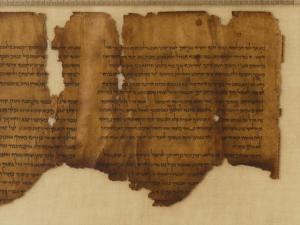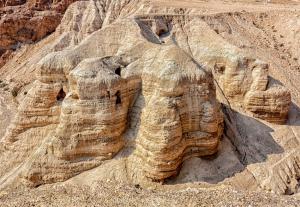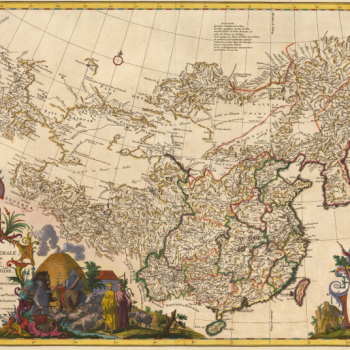
No doubt much of the fascination that surrounds the religious group that produced the Dead Sea Scrolls has to do with the fact that they were roughly contemporaneous with Jesus of Nazareth. What is more, a cursory reading of the Scrolls reveals much of the same vocabulary that would come to define Christianity. Here is talk of God’s atonement for the sins of humanity, of the war between light and darkness, the redemption and future glory offered to those who believe, and the eternal pit of fire reserved for those who do not. It is hard not to see at least a superficial likeness to Christianity in their skeptical, detached outlook toward contemporary society, in their fear of the body and obsession with purity, and in their fervent belief that God’s guiding hand was behind the movement of history. Their insistence that God had already chosen who to redeem to heavenly bliss and who to condemn to eternal hellfire before the world’s creation echoes the later ideas of St. Augustine and, ultimately, of Calvinism. And their system of communal organization does—even though saying so will earn no friends among contemporary scholars—bear more than a passing resemblance to Christian monasticism, particularly in the early form of the practice that emerged in the deserts of Egypt and Syria.
It is no surprise, then, that, until recent decades, scholarship on this group was undertaken largely with the aim of proving them to be the actual forbears of Christianity. For Christians, this strengthened their faith by suggesting that the manner in which Jesus, his followers, and later Christians interpreted the Bible was far more popular in first-century Judea than is usually supposed. For nonbelievers and opponents of Christianity, on the other hand, the faith would be diminished if its central creed could be shown to reflect not a universal need for salvation but the rather eccentric and parochial concerns of an isolated Jewish sect. Neither perspective quite did justice to Christianity or to the Dead Sea Scrolls themselves. Fortunately, they have largely given way to more balanced views (at least in the scholarly arena). The Qumran group were not Christians or proto-Christians. Though there are intriguing areas of overlap, there are also many issues on which the two are antithesis of one another. But what the existence of the Qumran community does demonstrate is that Christianity itself is a unique response to and reimagining of ideas, concepts, and arguments that already had considerable currency in the Judea of the first century.
It is often thought that the sect responsible for the Dead Sea Scrolls was a subset of the Essenes, a major school of Jewish thought from around the time of Christ that emphasized a strict adherence to the Mosaic law and a measure of separation from the rest of Judean society. The identification has never been conclusive, however, and remains a source of debate in scholarly circles. Still, the Qumran sect does display several of the Essenes’ trademark characteristics, including a rigorous application of the laws of Moses, a preoccupation with maintaining ritual purity, and a firm desire to see Judean society structured on thoroughly religious grounds. What does not always appear in accounts of the Essenes, however, is the high regard with which the Qumran group holds the institution of priesthood. Whatever the basis for this schism with the priests of the Temple, the Qumran group held the idea of the priesthood itself in high regard. Indeed, their vision for the reborn Israel of the end-times was one in which the priests sat atop the social pyramid.
Thus, the Qumran sect displayed the same unease regarding a royal messiah that did others did in this period. In a royal messiah they certainly believed; the Dead Sea Scrolls are full of prophecies, such as the rather famous War of the Messiah, that refer to the Messiah as “the Leader of the nation—the Branch of David” (Wise et al. 293). It is clear that for them, the restored heir of David would play a key role in the Last Days. But he is a surprisingly reduced figure. When he does appear in the Scrolls, it is usually not as a king dispensing justice but as the war leader of the army of Israel against the armies of the nations; indeed, he is most often called “The Leader of the Nation” or “The Leader of the Congregation” rather than “King of Israel.” Most of his great deeds, such as when, after the final battle in The War of the Messiah, “the king of the Kittim [Romans] shall stand for judgment and the Leader of the Nation—the Branch of David—shall have him put to death” (293), are done in a military capacity. And even then, his role is rather limited. He never commands the spotlight in the apocalyptic narrative.
That instead falls upon the soldiers who make up his army. It is they whom most of the apocalyptic texts, including the infamous War Scroll, tend to focus on. Indeed, the War Scroll itself might be an anomaly in the genre of apocalyptic literature; consisting largely of a set of rules including “The Rule of the Trumpets” (153) and the “Rule of the banners of the whole congregation according to their formations” (154) and “[t]he rule for arranging the divisions of war for when their army is complete to make a forward battleline” (155) that describe in exactly detail the make-up of the army, the hierarchy of command, the forms and appearance of various weapons, recruitment ages, battle plans, and various other kinds of military minutiae, the War Scroll may be the world’s only logistical apocalypse. Of course, since the Qumran community seemed to believe that they themselves would make up this army of God, this makes some sense. The War Scroll is something of a practical handbook for running an apocalyptic military. And besides, making themselves the starring players of the apocalyptic narrative was no doubt rather good for the community’s collective ego.
But the reduction of the Davidic messiah was not all about self-flattery, however. The Qumran sect shared the wider concern about a secular ruler, even one chosen by God, having too outsized of a role in the world’s religious redemption. Thus, the Qumran community sought, as others did, to give a more suitably religious veneer to the messianic moment. They were aware of the prophecies regarding Elijah and the second Moses. The latter one was a particular favorite and was often quoted. But even so, a new prophet was not exactly the right fit for the community of Qumran. Despite their status as outsiders living far from the seat of power in Jerusalem, they were by no means antinomian. The Jerusalem priesthood stood as the pinnacle of their ideal social structure. Thus, when they needed to find a suitable religious authority by which to sanctify the Israel of the end-times, they turned to the priesthood.
That the community of the redeemed Israel will be one in which the priests hold supreme power and govern everything is clear throughout the Dead Sea Scrolls. Many of the scrolls mentions that it is the priests who will lead the armies of the Lord into battle. The War Scroll even contains detailed instructions on how the priests are to conduct the apocalyptic campaign against the nations: “The one priest shall walk before all the men of the battle line to encourage them for battle. In the hands of the remaining six shall be the trumpets of assembly, the trumpets of memorial, the trumpets of alarm, the trumpets of pursuit, and the trumpets of assembly” (Wise 158), with the blast of each set of trumpets serving to communicate marching orders to the front line. Thus, if there are any central figures in the Qumran apocalyptic narrative beyond the undifferentiated mass of the “Sons of Light” who make up Israel’s army, it is the future priests of the Jerusalem Temple.
What is more, on the rare occasions when the Messiah is shown acting in his capacity as king, it is emphasized that his authority in the new, eternal Israel is second to that of the priests. A commentary on the Book of Isaiah states of “the Branch of David, who will appear in the Last Days” that “he will be advised by the Zadokite priests, and as they instruct him, so shall he rule, and at their command he shall render decisions; and always one of the prominent priests shall go with him” (211). Other texts note the priests’ constant presence around the Messiah, such as one that states, “from the priests, [there shall be] twelve, each man from his brothers from the sons of Aaron … And from the Levites twelve … and they shall be sitting with him continually for judgment and Torah” (404). Thus, while the Qumran community accepts that the Davidic messiah shall be King of Israel, they ultimately make him subordinate to the priesthood, always in their company and implementing their rulings on all matters rather than making his own. This ensures that secular rule will be merely an outgrowth of religious rule and that religious authority, embodied by the priests, will reign supreme in the Israel that is to be.
While this may be an effective way of addressing concerns about the traditional messianic vision being too secular, most apocalyptic narratives live and die by their characters, singular individuals destined to play a defining role in the cosmic drama. Faceless collectives and organizations never seem to generate the same sort of excitement. Perhaps this is what led the Qumran community to their most shocking and distinctive messianic innovation: the introduction of a second messiah. This second messiah would be the High Priest of the Jerusalem Temple in the Last Days, playing just as decisive a role in the end of history as the Davidic messiah, if not an even more decisive one. A text detailing the supposed last works of Levi, the ultimate progenitor of the priestly tribe of Levites, predicts that of this High Priest that “he shall make atonement for all those of his generation, and he shall be sent to all the children of his people. His command is like the command of Heaven, and his teaching is like the will of God” (259). Levi goes on to state how the Priest shall be involved in conflict: “They will speak many words against him, and many falsehoods; they will concoct lies and speak all kinds of slander against him. His generation is evil and perverse … his term of office will be marked by lies and violence and the people will go astray in his days and be confounded” (259). However, that the Priest will ultimately prevail is demonstrated by another text that states, “All their designs against him will fail, and the joy of all living things will be great … because he is the chosen one of God … his purposes will last forever” (428). The Priest, like any proper messiah, will face an apocalyptic struggle but shall triumph and establish an order of things that shall last into eternity.
The Priest and his role obviously seem to overlap with the Davidic messiah. Yet, he is clearly a distinct character. A number of scrolls mention the two of them together. One text speaks of “the shoot of David, who is to arise with the Interpreter of the Law, and who will arise in Zion in the Last Days” (228), differentiating the Davidic messiah from the religious “Interpreter of the Law” and emphasizing their joint appearance. The Charter for Israel in the Last Days, another text preoccupied with the logistics of the end-times, notes that at the victory banquet, “the Priest, as head of the entire congregation of Israel, shall enter first… Then the Messiah of Israel may enter” (147) and that when the meal is served, “none may reach for the first portion of the bread or the wine before the Priest. For he shall bless the first portion of the bread and the wine, reaching for the bread first. Afterward the Messiah of Israel shall reach for the bread” (147). The War of the Messiah, while it reserves judgment of the nations to “the Branch of David,” seems to give command of the army itself to the Priest during the apocalyptic final battle with evil: “And the High Priest shall stand before them and they shall arrange themselves against them in battle array” (293). These lines not only suggest that the Priest is a suitably messianic figure in his own right but even elevate him over the long-awaited Davidic king. He, rather than the Davidic messiah, seems to play the chief role in defeating evil and even at the victory banquet, the heir of David yields the pride of place to the messianic Priest.
Despite all this, the Davidic messiah is still understood as the commander of the redemptive army of Israel. His role is resolutely secular and military while the Priest’s is a religious one. That it is a religious one that allows the Priest to serve as field commander at the final battle says something about what the Qumran sect considered to be religious matters and how broadly they felt the authority of the priesthood should extend. But the fact remains that the Priest is a religious figure and that his mission to Israel is primarily to bring about a religious reformation. In this, he would seem to fulfill the role of the new prophet of the Second Moses prophecy. But the text commonly called the Community Rule distinguishes the coming Priest from the second Moses when it remarks of the Qumran sect: “They shall govern themselves using the original precepts by which the men of the Yahad [Qumran community] began to be instructed, doing so until there come the Prophet and the Messiahs of Aaron and Israel” (139). The Messiah of Israel is, as common sense and the rest of the Dead Sea Scrolls demonstrate, the Davidic messiah-king. The Messiah of Aaron is the messianic High Priest since, according to a proper application of the Mosaic law, he would have to be a descendant of Aaron to qualify for the priesthood. And the Prophet, surely the subject of the new Moses prophecy, is distinct from both. Aside from the bizarre implication that there will be three separate messianic figures in the end-times, this line demonstrations that the future High Priest is not expected to fulfill the role of prophet. His messianic mission, while still more religious than the Davidic king’s, will take a different tack from that of the new Moses.
This makes sense if we consider the importance that the Qumran sect placed on the priesthood. As the line of messianic commentary from the Dead Sea Scrolls above makes clear, the future High Priest was supposed to be an “Interpreter of the Law” rather than taking over Moses’s roles as a new lawgiver and father of a new covenant. Instead, he is going to do what the priests of the Temple were already supposed to be doing. But his judgments on the laws of Moses will be perfectly correct, unbiased, and comprehensive, unlike the contemporary temple priests whom the Qumran sect were so suspicious of. In short, then, he functions as an exact parallel to the Davidic messiah; just as the heir of David restores the proper functioning of Israel’s secular authority by returning the Davidic dynasty to the throne, the messianic priest will restore the proper functioning of Israel’s religious authority by taking over the Temple and interpreting the Mosaic law properly. Though just as the priests, in the Qumran sect’s thinking, should be superior to the secular authorities, so too will the High Priest be superior to the Davidic king. But like the Davidic messiah, the High Priest of the scrolls is fundamentally a conservative apocalyptic figure. Whereas the second Moses prophecy was at least open to radical interpretation, because a new prophet like Moses should at least be able to overturn the old law and covenant in favor of a new one, the High Priest and the Davidic messiah both promised a return to a long-vanished Israel where the House of David was still on the throne and the priests interpreted the Mosaic law without controversy. It was a restorative model that appealed to all the traditionalist sensibilities—of which there were many—of the Qumran community.

The Qumran sect, whether they were Essenes or not, ceased to exist long ago and never saw their dreams of a restored priestly Israel come to fruition. But some of their apocalyptic ideas, or ideas very much like them, stuck around. Their idea of a multitude of believers collectively bringing about the regeneration of the world and the victory over evil has some antecedents in Zoroastrianism (and is far from the only potential sign of Zoroastrian influence in the scrolls) but imagining this multitude as a community of exceptionally pious individuals living together in a kind of religious order was indeed an innovation in apocalyptic thought. At first, it was not one that caught on. Christianity, Islam, and later forms of Judaism all seemed to prefer a model in which one or a few dominant personalities determine the course of end-times events. But Joachim of Fiore, creating his own revolutionary apocalyptic system over a thousand years later, would have his transformative Age of the Holy Spirit come about through the actions of a collective of vires spirituals (“spiritual men”) who gathered together in two new monastic orders.
Given the separation in time and space between the Qumran group and the Italian prophet, direct inspiration seems unthinkable, but Joachim did take an active interest both in Jewish thought and in alternative readings of the Old Testament. And what is arguably the most important of the Qumran group’s texts, the Damascus Document, was apparently still circulating in Jewish communities at the time. The Damascus Document, a pivotal statement of the Qumran sect’s theology, history, and principles of social organization, was among the first of the group’s texts to be discovered in modern times, emerging out of the medieval Ben Ezra Synagogue in Cairo roughly a half century before the first discovery of scrolls near the Dead Sea. The Damascus Document had survived there in two copies, one produced in the tenth century and another created in the twelfth. The latter was Joachim’s own century, which means that this crucial Dead Sea text was still being copied and distributed near to or even within his own lifetime. Academic scholarship has never seemed to fully reckon with the fact that, despite the sect supposedly ceasing to exist in 68 C.E. when the Romans destroyed Qumran, their teachings were still being passed down in certain Jewish congregations over a thousand years later. Given that Joachim had contacts in the Jewish community and made a concerted effort—practically unheard-of for a Christian of the time—to learn about Jewish beliefs and draw upon their interpretations of scripture, it is not impossible that he met with and absorbed some of the Qumranites’ ideas. But regardless of whether Joachim managed to indirectly imbibe some of the Damascus Document‘s key notions, the later success of Joachim’s system at least demonstrates that the notion of collectively achieved salvation had not lost any of its appeal in the eleven-hundred years that separated him from the sectarians of Qumran.
The other great innovation of the Qumran community was the two-messiah theory. While the exact form it takes in the Dead Sea Scrolls is unique to the Qumran sect, the idea of two separate messiahs would keep recurring after they were long gone. Judaism had perhaps already been inching toward it with the new Moses and returning Elijah prophecies. But, as the Jewish Encyclopedia notes, by the second century of the common era, “the notion prevailed that Elijah’s office was ‘to bring peace and adjust all differences’ … It was expected that all controversies and legal disputes which had accumulated in the course of time would be adjusted by him, and that difficult ritual questions and passages of Scripture seemingly conflicting with each other would be explained, so that no difference of opinion would exist concerning anything … The office of Interpreter of the Law he will retain forever” (Hirsh et al. “Elijah”). Thus, within a few centuries, Elijah had come to take over the role that the Qumran community assigned to the priestly messiah, even taking on his title as “Interpreter of the Law.” The similarity of the conception of Elijah, and its arising soon after the dispersal of the Dead Sea sect, is very suggestive. But it is not the only possible line of influence from the Dead Sea to later forms of Judaism.
Judaism would come to develop a more proper two-messiah tradition, one that would pair the “Messiah ben David” (the Davidic messiah), with the “Messiah ben Joseph.” This figure, descended from Joseph, would, according to the Jewish Encyclopedia, “gather the children of Israel around him, march to Jerusalem, and there, after overcoming the hostile powers, reestablish the Temple worship and set up his own tradition” (Jacobs and Buttenweiser, “Messiah”). Thus, we have a second messiah who shall balance the secular Davidic messiah by restoring the proper form of worship to the Temple. In this, he fulfills exactly the role earmarked for the messianic priest in the Qumran sect. What is more, he seems to also fulfill the Second Moses prophecy; as we have previously seen, descent from Joseph is, at least amongst the Samaritans, the major qualification for someone to be the Second Moses. The Jewish Encyclopedia, written some decades before the discovery of the Dead Sea Scrolls, observes that, “When and how this Messiah-conception originated is a question that has not yet been answered satisfactorily” (“Messiah”). Now with the scrolls’ discovery and translation, we have a possible prehistory of this idea. It is impossible to know if later messianic Judaism owed anything directly to the Dead Sea community or to the faith’s Samaritan rivals but it seems likely that such ideas were very much in the air at the time when rabbinical Judaism was beginning to take shape in the first and second centuries of the common era.
The two-messiah theory also reoccurs in Christianity and Islam. Islam, like Christianity, makes Jesus the messiah who will return to vindicate the true religion and strike the final blow against evil. But the common belief amongst Muslims is that the Mahdi, a righteous descendant of Muhammad, will precede him. The Mahdi will unite the faithful under his rule and wage victorious campaigns against the unbelieving nations and the armies of darkness. As for Christianity, the New Testament places a heavy emphasis on the fact that Jesus is the one and only messiah. But that did not stop medieval Christianity from tacking on a second one. This was the figure of the Last World Emperor, a great Christian monarch who would defeat the faith’s enemies in the last days and establish a universal Christian empire before Jesus returned. As a secular savior, he produced the same sorts of anxiety as the Davidic messiah once had. Joachim of Fiore tried to fix this, in a move reminiscent of the Qumran community’s own, by transforming the Last Emperor into the Angelic Pope, a supremely beneficent pontiff who would transform the church and purify its religious ideas. Later would-be prophets simply added the Angelic Pope into the apocalyptic scheme alongside the returned Christ and the Last Emperor, accidentally recreating the messianic trio found in the Community Rule of the Dead Sea Scrolls.
Once again, it is difficult to pinpoint any direct line of transmission between the Qumran community’s two-messiah program and those of Christianity and Islam. Indeed, both could simply have arisen out of a dissatisfaction with Jesus’s well-known pacifism and a desire for a more muscular and militant leader to drive the action of the Last Days. Certainly, Buddhism saw the peaceful Buddha-to-be Maitreya independently supplemented with conquering kingly messiahs in China, India, and Tibet, and it would take a vast leap of the imagination to link any of these places to Qumran. But the portrayal of the Mahdi and the Last Emperor as military heroes subservient to a religious messiah is intriguingly similar to the Qumran community’s balancing of the High Priest and Davidic king. And both concepts did arise in roughly the same place and time, the Syria-Palestine region in the later seventh century. A cache of Dead Sea Scrolls had already been unearthed in the third century and entered circulation (one of them found its way to Origen, the great and controversial Christian theologian). A large cache of over two-hundred scrolls would be discovered at the turn of the nineth century. Thus, the reemergence of Dead Sea Scrolls at this time was not unheard of. It is possible that some scroll containing the two-messiah theory, from either the third-century find or a later, unrecorded one, entered circulation and its ideas became enough a part of the general atmosphere of messianic speculation in the region to influence the formulation of concepts such as the Mahdi and the Last Emperor. Or perhaps the two-messiah theory had already seeped into the general cultural atmosphere during the first century and had simply never left.
Such possibilities are, however, highly speculative. It could simply be that, once again, the Dead Sea community foreshadowed rather than directly influenced later developments. However, there is still an uncanny similarity between the two-messiah theory and those later developments. This demonstrates that, if nothing else, the Qumran sect was responding to concerns and conundrums that would not go away by the seventh century, and perhaps have not gone away to this day. Their theory of dual messiahs was particularly apt at responding to these concerns, and thus would reappear in faiths that were far more widespread and successful than the sect of Qumran. And, along with the Second Moses prophecy, the two-messiah theory demonstrates that there was at least some desire for the messiah to bear a religious cast and act primarily as a reformer of faith. This same desire, albeit manifesting in quite a different way, would soon give rise to the remarkable career of Jesus of Nazareth, who would ever afterward be known by the messianic epithet of “Christ.”
A Note on Sources
For the text of the Dead Sea Scrolls themselves, I have relied upon Dead Sea Scrolls: A New Translation, edited and translated by Michael Wise, Martin Abegg, Jr., and Edward Cook (San Francisco: Harper Collins, 1996). My citations are from this edition, though I have cleaned up the quotations from the unique way (intended to indicate gaps and reconstructed text) in which they are presented there. Naturally, given the fragmentary state of the scrolls, all professional translations and interpretations are inevitably tentative, but I have still chosen to defer to the translators’ readings and reconstructions.
For background information on the Essenes, the scrolls, and the history of scrolls scholarship, I have relied upon two texts, Joan E. Taylor’s The Essenes, the Scrolls, and the Dead Sea (Oxford: Oxford University Press, 2012) and John J. Collins’s The Dead Sea Scrolls: A Biography (Princeton: Princeton University Press, 2012).
Citations from the Jewish Encyclopedia come from two articles that I have also cited in previous entries. They are: Hirsh, Emil G., König, Eduard, Schechter, Solomon, Ginzberg, Louis, Seligsohn, M., and Kohler, Kaufman. “Elijah.” The Jewish Encyclopedia, 1906. ELIJAH – JewishEncyclopedia.com. Jacobs, Joseph and Buttenwieser, Moses. “Messiah.” The Jewish Encyclopedia, 1906. MESSIAH – JewishEncyclopedia.com.












